
Stop reading this. Go vote. It’s Election Day, and for the first time since 2008, America is going to elect a brand new president. If there’s a future to be had, that president will be one of the most experienced and qualified human beings to ever hold the office. If not… well, let’s just say you can take these upcoming post-apocalyptic films as an opportunity to review your options.
We all know what goes into making a post-apocalyptic movie. My only rule for this list was that anything involving zombies would be ineligible. Although not being able to talk about films like 28 Days Later and The Omega Man really hurt, they would have dominated the genre otherwise. I’ve done my best to choose varied worlds, just for the sake of adding colour to what might otherwise be a grim set of future events.
Don’t pay too much attention to the actual ranking. Just because a film isn’t at number one doesn’t mean it’s not the best. Consider these ten of my favourite post-apocalyptic films that I think are worthy of discussion. So if you’ve already voted and are trying to take your mind off events yet to come, look no further. Tonight we’re rescheduling the apocalypse.
-
Oblivion
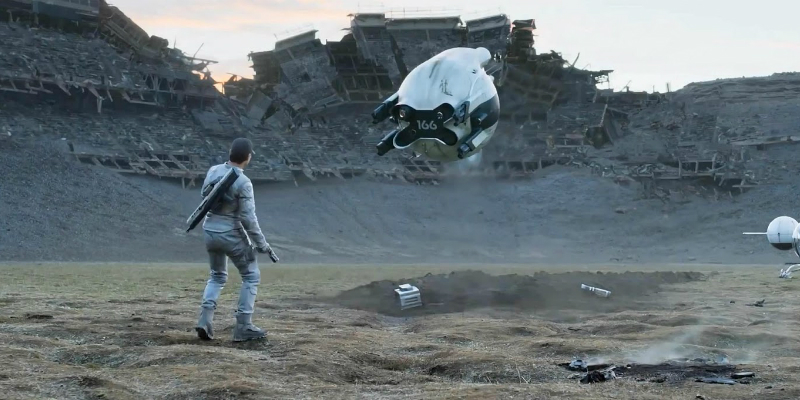
The cause of the apocalypse? Aliens.
Joseph Kosinski is often criticised for creating films with more style than substance, but I loved his vision of a dead Earth standing eerily flat and silent. The most memorable aspect of this film is the sense of scale. Tom Cruise actually looks small when shown alone in the middle of a stadium. Wandering through crumbling urban landscapes, you wonder why everything was built so large. It’s a sense of scale we often lose in modern life, a reminder that cities, built for millions, are now inhabited by just one man.
In one of the coolest twists on this list, we learn that Cruise’s character isn’t actually a steward of humanity like he thinks he is, but rather a mere pawn of the aliens who are siphoning Earth’s energy dry. We get a sense that the world has ended because of something so much bigger than us pulling the strings, and the cosmic horror of that potential sits with you for a while. This isn’t Independence Day. It’s the post-apocalyptic aftermath of an alien invasion where there’s nothing you can do. I thought it was a fun ride, and we all love to watch Tom Cruise punching himself in the face.
-
Wall-E
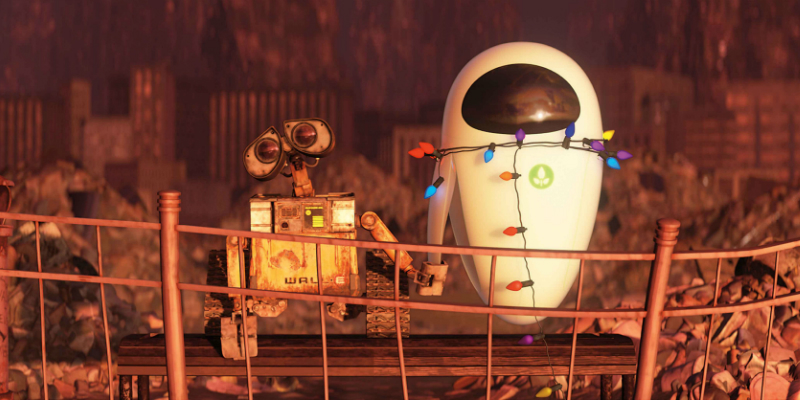
The cause of the apocalypse? Capitalism.
Pixar’s Wall-E doesn’t immediately strike you as being post-apocalyptic. But guess what? For the first half of this Pixar film, we are alone on a dead world without any signs of life. Humanity is gone. Only the cockroaches have survived. This is a totally dead world that only one lonely robot still calls home. In fact, it’s the only way he’s ever known the world, and the way he pieces together the artefacts of our consumer culture to create such a charming little personality speaks volumes about our own priorities in life.
It’s stated pretty openly that the capitalistic demands of owning more stuff and not caring about the consequences of our consumption led to the collapse of the Earth’s atmosphere as a garbage planet. Humans left the planet with the intention of their robots cleaning up the mess and making it habitable once more for their return. When we get to see how humanity’s ended up since leaving Earth behind, it really gets depressing. The moral? Don’t elect Fred Willard to office.
-
The Road
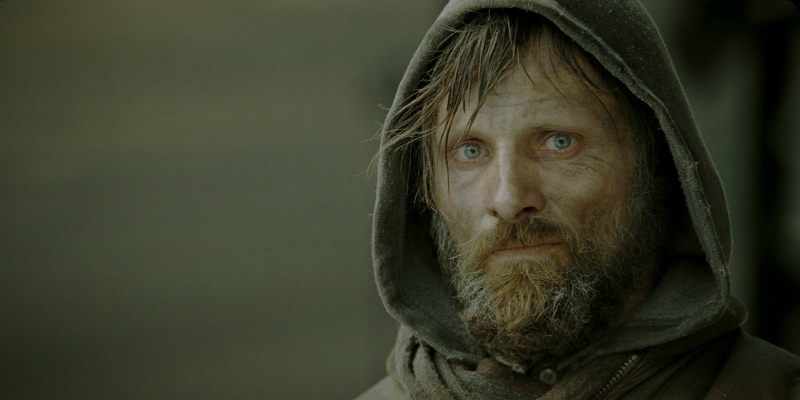
The cause of the apocalypse? Unknown.
Nothing is as bleak or beautiful as Cormac McCarthy’s post-apocalyptic novel The Road, adapted to a film version in 2009. John Hillcoat directed what turned out to be a remarkably faithful version of the source material, leaving the grim tone entirely intact. The stoic Viggo Mortensen as an unnamed father protecting his son as they make a pilgrimage south towards warmer climate. I read the book long before ever seeing the film on this one, and I’m still impressed by the slow-moving step-by-step journey this story makes. The way it presents scavenging and surviving as essential to daily life makes you feel the world is dying. Society is truly incapable of picking itself back up again in this world, and you entirely understand why.
The smartest part of this post-apocalyptic wasteland that McCarthy created was the lack of definitive answers as to the cause of the apocalypse. Although we can make assumptions or guesses as to what it was, we’re in the same boat as the characters in that we have no idea what actually caused the world to end. We know it’s an event of recent memory, and that something was seen in the sky that resulted in an atmosphere thick with ash, but in both the book and the film the specific cause remains unknown. It’s the consequences, the inhuman dregs that represent the last people to survive the harsh wasteland of reality, that really make the film stand out.
-
Children of Men

The cause of the apocalypse? Infertility.
Did I say nothing was as bleak or beautiful at The Road? That’s debatable. I forgot about Children of Men. Hauntingly precient in the face of a post-Brexit world, Alfonso Cuarón took P.D. James’ gripping dystopian novel and turned it into a commentary on immigration and prejudice in an unkind world. The long-takes in the film are legendary, and Cuarón created a reliable glimpse into the year 2027 via the use of small details such as Clive Owen’s well-worn London 2012 sweater or Michael Caine’s stories of the past. It could probably be described as more dystopian than apocalyptic, but it gets included for the sake of being just a damn good film.
No kids? No future. It’s a simple concept that’s far more damaging via implication than actual instant change. Nothing really causes this society to end other than depression and inevitability. You get the sense that the apocalypse has been a long time coming. Not with a bang, but a whimper. The aging cast are fundamental to creating a believable atmosphere of a world without children, with the youngest member of the cast being the nineteen year old Clare-Hope Ashitey as Kee, putting in a remarkably moving performance of a woman who is both unready for motherhood and the last chance for humanity’s survival.
-
Waterworld

The cause of the apocalypse? Global Warming.
I admit that ranking any film from Kevin Costner’s epic post-apocalyptic phase so high is a bit of a stretch, but I did you the solid of at least only choosing one of my guilty pleasures, so I saved you the three hours it would have taken to watch The Postman. At the very least, you have to admit Waterworld is one of the more unique concepts on this list. The design and cohesion of the ocean planet brings with it a wealth of opportunity. It’s a shame that the potential was never truly reached. It might just be an expensive rip-off of Mad Max, and that’s super-obvious by the inclusion of “the smokers” as its villains, but it gets a lot of credit with me for what it tried to accomplish.
In all honesty, I think about Waterworld a lot. The ice caps are melting, and a change this extreme in Earth’s topography is not entirely unreasonable. This is an idea that would be ripe for an animated reimagining with the right team. The endless expanse of ocean in this apocalyptic world that is so genuinely different than the dusty, dreary landscapes we so often associate with the genre. Just don’t try to actually film on the ocean or let Kevin Costner near the apocalypse ever again.
-
Nausicaä of the Valley of the Wind
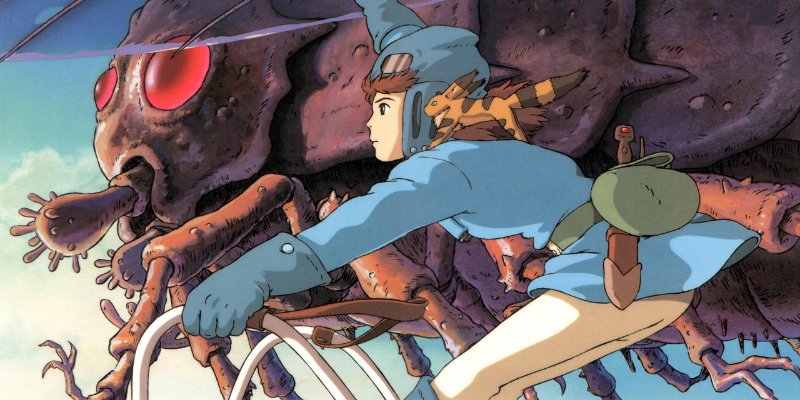
The cause of the apocalypse? Pollution.
There. See? I made you sit through Kevin Costner, but I’m giving you a little Miyazaki to make up for it. This was originally ranked higher in my list, but I think you needed to hear about it now. Every now and then, you find yourself in a post-apocalyptic world that is simply breathtakingly beautiful. Miyazaki’s Nausicaä of the Valley of the Wind takes place a thousand years since the fall of modern society and presents a lush environment of wind and water. The Valley of the Wind is a utopia amongst feuding kingdoms, and even Patrick Stewart comes out to make you feel welcome with his sonorous baritone.
This movie plays like the anti-apocalypse. It’s been a thousand years since the Seven Nights of Fire that truly ended the world, and nature has truly retaken her rightful claim to the Earth, actually cleansing the man-made pollution out with gentle, refreshing plantlife that the people of the Earth entirely misinterpret. Lush plants and beautifully rendered visuals in all directions make you want to live here. Really, the only thing to worry about in this world are the insects, but the film’s dual messages of pacifism in the face of anger and living in harmony with nature are beautiful enough to put up with a couple of angry bugs.
-
12 Monkeys & La Jetee
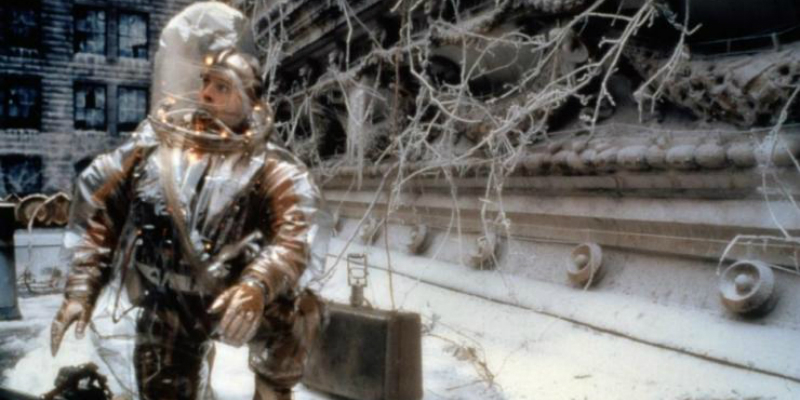
The cause of the apocalypse? Biological Warfare.
I love a little time travel in my apocalypse. 12 Monkeys gives us ample opportunity to see a future version of New York that includes lions roaming wild. Imagine a world that’s so far gone that the only way to escape it is to travel to another time. It’s one of Bruce Willis’ better performances, and Terry Gilliam does a pretty great job of constantly disconnecting you from the narrative with his visual flair and constant recontextualization of the past, present, and future.
Of course, it’s not exactly original. La Jetee is really my greatest love when it comes to this story. It’s a 1962 French film told entirely through still photographs. The fact that we see not only the past in La Jetee, but a vision of the future’s future as well, not to mention that the future’s future is responsible for fixing the past, makes it a whole bunch of timey wimey nonsense that I eat up with a spoon. With only a half-hour runtime, it’s definitely worth tracking down to see the origin of ideas used in films like 12 Monkeys and The Terminator years later.
-
H.G. Wells’ Things to Come

The cause of the apocalypse? Global War.
Oops, my film nerd is showing. An old school shout out, this screenplay written by H.G. Wells is a direct rebuttal to War of the Worlds. The most memorable scenes of this film take place in a new Dark Age with several members of the population infected with a “wandering sickness” so it almost stretches my “no zombies” rule, but I don’t think enough to break it. It’s a fantastic anti-war statement and definitely my favourite film that actually takes you through the full cycle of seeing the world as we know it descend into chaos and madness before actually pulling itself back up again, only to leave you wondering if the cycle is going to take place all over again.
In contrast to any post-apocalyptic movie where the nuclear end to war presents the tipping point, the act of war itself is what causes the end of the world, as people slowly lose more and more to the cause and all technology not dedicated to the war effort is lost. It’s probably also the most optimistic take on the apocalypse, as it’s one of the few films to show humanity overcoming it within a single generation to create a better world from the ashes of the old. When John Cabal comes flying back into the movie on his futuristic aircraft, it’s a representation of what we can be when we come together, rather than pit faction against faction.
-
Tank Girl
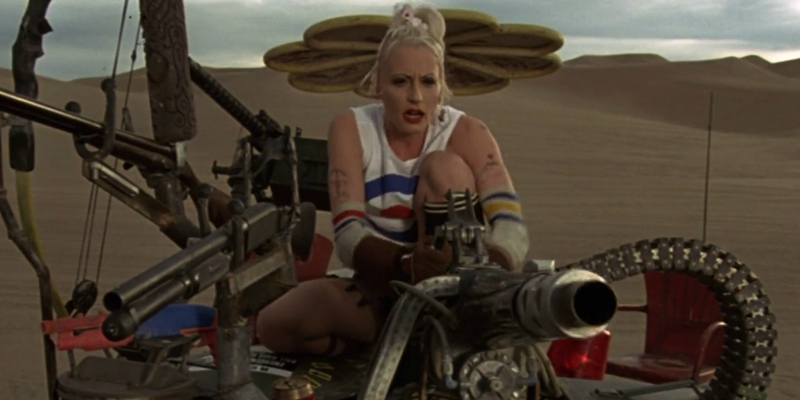
The cause of the apocalypse? Comet Impact.
Hell yeah. Tank Girl is fun. Tank Girl is crazy. Rachel Talalay directed it and there’s a deleted scene with a ten inch kangaroo-hybrid penis. What’s not to like? While it’s definitely the most ‘90s post-apocalyptic vision I’ve ever seen, this film has a reckless sense of abandon to it that just drives me wild. Certain scenes are actually animated using the comic panels from the source material, giving it a real punk flair. Knowing how much trouble this film had in even getting made in the first place, you can feel how Talalay and company made Tank Girl a film that feels as rebellious as the characters within it.
Tank Girl herself tells us in an opening monologue that this apocalypse began when a comet crashed into the Earth and disrupted weather cycles enough that it hasn’t rained in eleven years. This causes a massive shift in society, as the Department of Water and Power becomes an omnipresent force. Lori Petty brings her A-game in this movie. You completely believe the manic, inconsequential thought process of Tank Girl as she indiscriminately kills her enemies and makes jokes the whole time. It’s a different breed of character than we’re used to in these movies and one that is entirely welcome. Her position as anti-heroine of this film really captures the lawless anarchy of a post-apocalyptic world. If you don’t think it deserves the number two spot, it means you don’t know how to have fun. And tank girls? They wanna.
-
Mad Max

The cause of the apocalypse? Nukes.
This was inevitable. It’s the apocalypse franchise to end all other apocalypse franchises. After creating the world in 1979 with the original Mad Max, director George Martin came back for a final instalment with Fury Road and created a major hit in the process. The revival became an unexpected darling of the series by pushing feminist themes and heart pounding vehicular action to their limits.
While the earlier Mad Max films seemed to take place in a world only just past the tipping point of apocalypse, it’s only ever gotten weirder and more desperate in their utilitarian repurposed aesthetic as time has gone on. The cause of this particular apocalypse is unexplained by most of the franchise, but the presence of mutants and an ever-dying world betray the hint of a nuclear starting point. By the time we get to Fury Road, humanity has descended to a level of subhuman nomadic tribes. The franchise has become the staple of what a post-apocalyptic movie should be, and you can see in several of the films that ranked lower on the list that the Mad Max influence is strong.
Don’t Make These Post-Apocalyptic Films a Reality.
Now, like I said earlier: stop reading this. Go out and vote. And we all know who for. Don’t hand the world over on a silver platter to Immortan Trump Joe.



